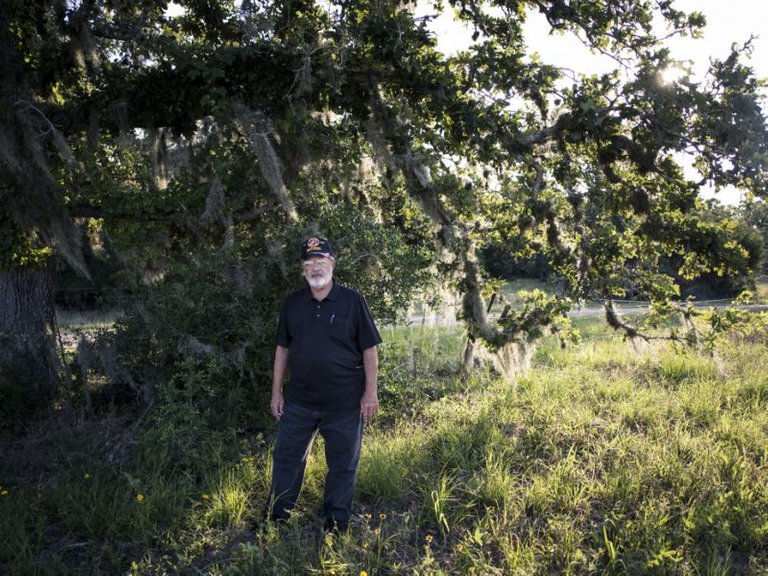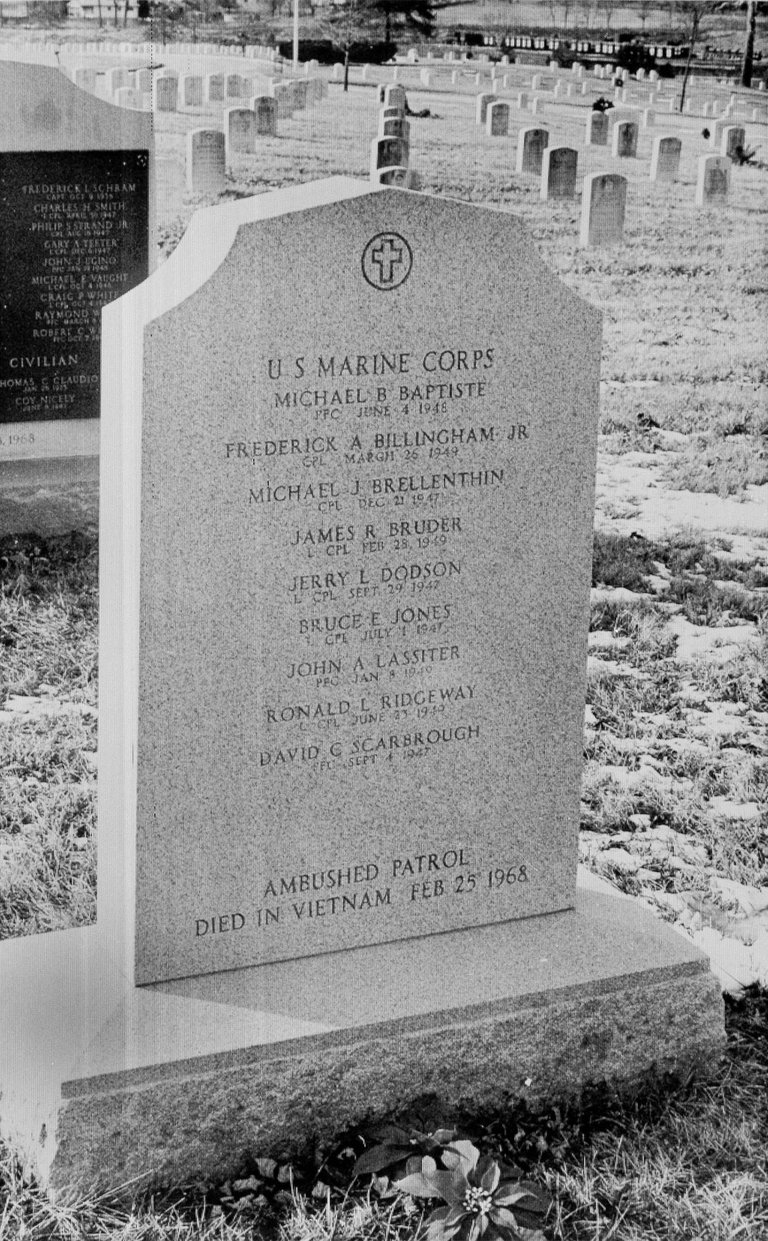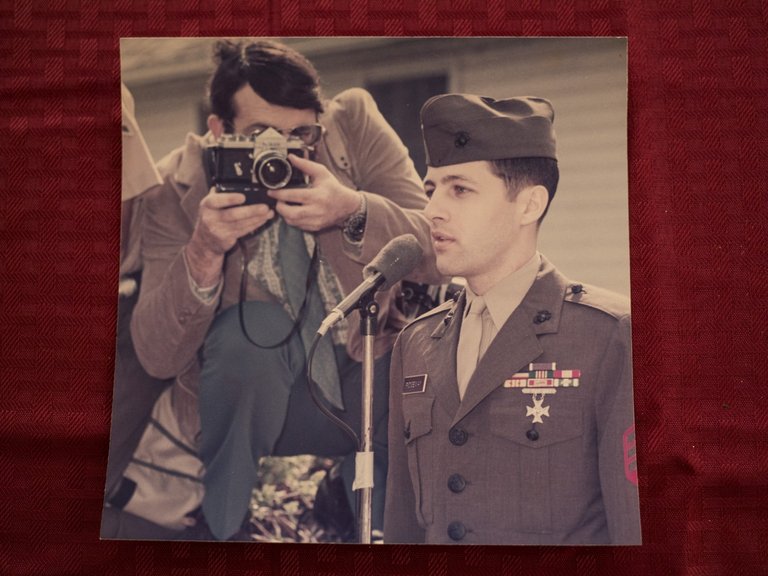
Retired Marine Ronald L. Ridgeway was 18 years old in 1968 when his patrol was attacked in Vietnam. He was captured and held prisoner for five years before being released, a time during which he was believed dead. (Matthew Busch for The Washington Post)
HALLETTSVILLE, Tex. — Ronald L. Ridgeway was “killed” in Vietnam on Feb. 25, 1968.
The 18-year-old Marine Corps private first class fell with a bullet to the shoulder during a savage firefight with the enemy outside Khe Sanh.
Dozens of Marines, from what came to be called “the ghost patrol,” perished there.
At first, Ridgeway was listed as missing in action. Back home in Texas, his old school, Sam Houston High, made an announcement over the intercom.
But his mother, Mildred, had a letter from his commanding officer saying there was little hope. And that August, she received a “deeply regret” telegram from the Marines saying he was dead.
On Sept. 10, he was buried in a national cemetery in St. Louis. A tombstone bearing his name and the names of eight others missing from the battle was erected over the grave. His mother went home with a folded American flag.
But as his comrades and family mourned, Ron Ridgeway sat in harsh North Vietnamese prisons for five years, often in solitary confinement, mentally at war with his captors and fighting for a life that was technically over.
Last month, almost 50 years after his supposed demise, Ridgeway, 68, a retired supervisor with Veterans Affairs, sat in his home here and recounted for the first time in detail one of the most remarkable stories of the Vietnam War.
As the United States marks a half-century since the height of the war in 1967 and ’68, his “back-from-the-dead” saga is that of a young man’s perseverance through combat, imprisonment and abuse.
 Marines in 1967. He was 18 when he was captured, 19 when his funeral was held and 23 when he was released from prison in 1973.
Marines in 1967. He was 18 when he was captured, 19 when his funeral was held and 23 when he was released from prison in 1973.
[The ‘lucky ones’: Marines who survived Vietnam gather to remember]
“You have to be willing to take it a day at a time,” he said. “You have to set in your mind that you’re going to survive. You have to believe that they are not going to defeat you, that you’re going to win.”
‘Everybody’s dead’
About 9:30 on the morning of Feb. 25, Pfc. Ridgeway’s four-man fire team charged an enemy trench line.
The curving trench seemed empty when they got there. But as Ridgeway and the others made their way along it, suddenly an enemy grenade dropped in.
“We back around the curve,” he recalled. “It blows up.”
“We throw a couple grenades,” he said. “We backed off. . . . Then we realized the firing [from Marines] behind us had almost died down to nothing.”
When they stood up to look around, they saw North Vietnamese soldiers walking through the underbrush toward them. “I guess they thought we were all dead,” he said.
“We cut loose on them,” he recalled. “They were easy targets.”
Ridgeway had been part of a platoon of about 45 men sent out from the besieged Khe Sanh combat base, in what was then northern South Vietnam, to find enemy positions, and perhaps capture a prisoner.
The enemy’s noose around the Marine base had been tightening, with heavy mortar and artillery fire, and the patrol was hazardous. Six thousand Americans were surrounded by 20,000 to 40,000 North Vietnamese soldiers.
On that foggy morning, the patrol’s leader, 2nd Lt. Donald Jacques, 20, strayed off course and was drawn into a deadly ambush, Jacques’s company commander, Capt. Kenneth W. Pipes, said.
More than two dozen Marines, including Jacques, were killed.
[A young officer’s death is captured by a doomed photographer]
One of the Marines in the trench with Ridgeway, James R. Bruder, 18, of Allentown, Pa., was cut down as the enemy returned fire, according to author Ray Stubbe’s book about Khe Sanh, “Battalion of Kings.”
“Stitched him across the chest and killed him,” Ridgeway remembered.
The fire team leader, Charles G. Geller, 20, of East St. Louis, Ill., took a peek, and a bullet creased his forehead, knocking him down.
“Everybody’s dead,” Geller said, according to Stubbe’s book. “Everybody behind us is dead. . . . What are we going to do?”
They had to retreat. Geller left first, running back across the field where they had charged, followed by Ridgeway.
The son of a Southern Pacific railroad worker, Ridgeway came from a working-class neighborhood of Houston. He had a younger brother.
His parents were divorced. He had left high school and joined the Marines because “I wanted to get away,” he recalled.
As he and Geller ran to the rear, they came upon Willie J. Ruff, 20, of Columbia, S.C., who was lying on his back with a broken arm.
“We were in a hurry,” Ridgeway said. “But we stopped. He was wounded.”
As Geller knelt beside Ruff, a bullet hit Geller in the face, leaving a terrible wound. Then Ridgeway was struck by a round that went through his shoulder. All three men were now down.
“All we could do was lay there and play dead,” he said. “We were in the wide open.”
Ridgeway said he drifted in and out of consciousness. When Geller, who was delirious, got to his knees, the enemy threw a grenade, killing him.
Ridgeway said the North Vietnamese then began shooting at Marines who had fallen in front of their trenches. “They’re popping the bodies to make sure they’re dead,” he said.
One bullet hit the dirt near him. A second glanced off his helmet and struck him the buttock, he said.
“When that hit, it jarred the body,” he said. “They figured they got me. Left me for dead and kept working their way down past me.”
Ridgeway passed out again. When he woke up, it was dark and American artillery was pounding the area.
Ruff said he had been hit again and begged Ridgeway not to leave him. Ridgeway said he wouldn’t. At some point that night, Ruff died.
Ridgeway was awakened the following morning by someone pulling on his arm. He thought at first it was fellow Marines.
But when he looked up, he realized it was a young North Vietnamese soldier trying to pull off his wristwatch.
Agony and identification
After the firefight, the shattered survivors of the patrol made it back to the combat base, and the dead were left on the battlefield.
A rescue mission was deemed unwise by higher-ups, who feared losing even more men and depleting the base’s defenses, according to Pipes, who is now retired and lives in California.
In a telephone interview, he said that with binoculars, he could see Marines’ bodies strewn on the battlefield. “It was worse than agony,” he said. No further patrols outside the combat base were immediately permitted.
“We couldn’t go get them,” he said. “They laid out there for six weeks.”
On March 17, he wrote to Ridgeway’s mother: “I am sorry that I can offer no tangible basis for hope concerning Ronald’s welfare.”
Finally, on April 6, the Marines were able to return to the battlefield, Pipes said.
What was left of the dead was brought back to Khe Sanh’s temporary morgue, where Pipes and others went about the grisly task of identifying the dead. “There wasn’t much there but bones and shoes and boots . . . [and] dog tags,” he said.
In the end, of the 26 missing and presumed killed in action on Feb. 25, remains of all but nine were positively identified, according to Pipes and Stubbe.

The day of the funeral at the Jefferson Barracks National Cemetery was sunny and cool. Ridgeway’s mother attended, and there were flags and solemn honors. A newspaper photographer took pictures.
Far away, in North Vietnam, the rainy season was on, and Ridgeway was in his seventh month as a POW.
The work of surviving
As he sat alone in his windowless cell beside a wooden bed and the bucket he used for waste, Ridgeway went about creating a “make-believe” life.
There was no one to talk to, and he was only allowed out once a day to empty the bucket.
So he imagined that he was somewhere else, that he owned a pickup truck, that he had a wife and children, that he would go fishing.
It was a mental exercise, he said, and he found that spending three days in his make-believe world would take up a whole day in solitary.
Ridgeway said that by then, his captors considered him a “die-hard reactionary” and all Marines “animals.”
He hadn’t cooperated with his guards. He had lied to interrogators, pretended he was green kid who had never fired his rifle and gave them bogus military information.
The startled North Vietnamese soldier had locked and loaded his rifle when he realized Ridgeway was alive that morning.
Ridgeway expected to be killed. “You didn’t hear about prisoners being taken,” he said. But he was bandaged, fed and marched away, through Laos and into North Vietnam.
He spent time in several jungle camps, held in wooden leg stocks, and he eventually wound up in enemy prisons.
He got lice, malaria and dysentery and lost 50 pounds. He wore pink-and-gray-striped POW pajamas and rubber sandals, all of which he brought home with him when he was freed.
He was beaten with bamboo canes and tied up during interrogations.
One interrogator the Americans named “Cheese” — because he seemed to be the big cheese — was especially cruel.
He spoke English and sat up on a high chair as he questioned POWs tied on the floor. When he nodded his head, a guard would strike the prisoner with the bamboo cane.
He had a face like a rat, Ridgeway recalled, and was a “mean . . . sadistical son of a b----.”
Ridgeway said he didn’t dwell on the notion that people back home might think he was dead. They would be fine. His job was to survive.
In January 1973, he was in North Vietnam’s notorious Hanoi Hilton prison when his captors abruptly announced that the POWs were to be freed as part of a peace agreement before the U.S. withdrawal from Vietnam.
 Ronald Ridgeway is photographed in 1973 shortly after his release from POW camps in Vietnam. (Family photo)
Ronald Ridgeway is photographed in 1973 shortly after his release from POW camps in Vietnam. (Family photo)